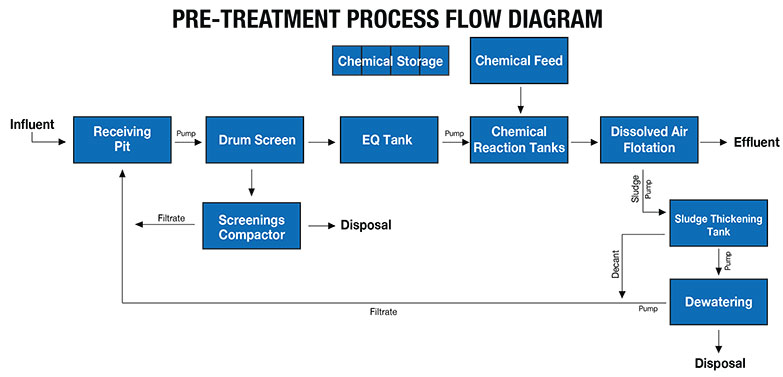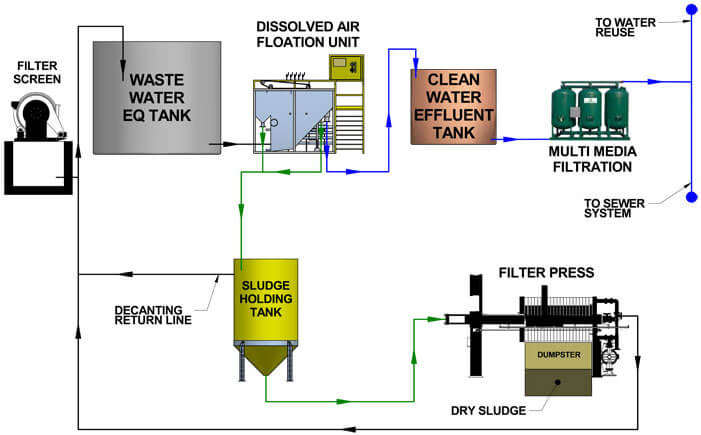Meat & Poultry Producers Wastewater Treatment

INDUSTRY TYPE – Food Processing – Meat & Poultry Producers
In the meat processing industry, water is used extensively for washing the cattle, sheep, or pig carcasses. Water is also used for sanitizing and thoroughly cleaning all equipment used in the process at the facility. A large quantity of water is also used for scalding of hogs to facilitate hair removal. Federal regulations dictate that a complete cleaning and sanitation process be conducted after every killing and processing shift at the plant. This cleanup period generally uses considerably more water than the actual processing of the meat. As a result of there often being time between shifts and the processing cleanup phases, the generation of wastewater can be inconsistent. Ecologix provides comprehensive wastewater treatment technologies and services for every facet of the meat and poultry processing industries. From preliminary screening of grit or feathers to physical/chemical separation and sludge management, we will help bring your facility into compliance with local wastewater discharge permit requirements.BACKGROUND / HAZARDS PRESENTED BY FOOD & BEVERAGE PRODUCER WASTEWATER
All types of meat processes generate wastewater with similar characteristics. They each contain high levels of TSS, FOG, and BOD, making them hard on a municipal treatment plant that may become overwhelmed when it also has many other customer flows to handle. The inconsistent nature of meat and poultry processing plant flows only exacerbates this difficulty, because the downstream municipal plant cannot easily anticipate and plan for high-load flows.In these types of facilities, cities do the only thing they can to compensate for this difficulty: They collect monetary surcharges from high-load customers, based on discharge loadings. These surcharges can reach tens of thousands of dollars per month, taking a significant bite out of profitability.
When such a situation gets to the point where the municipal wastewater treatment facilities are regularly overwhelmed, unable to handle flows from high-load industries, cities may decide to terminate discharge permits. This forces businesses to either figure out a solution or shut down their plants entirely. This not only creates a bad situation for the business, but can disrupt entire economies in smaller (especially rural) areas.
Do not wait for such a scenario to creep up on your operation. Instead, choose to install our Enhanced Dissolved Air Flotation (DAF) system, the best pretreatment option for such cases. By applying this type of physical/chemical separation process, facilities can completely remove TSS, FOG and high concentrations of BOD. When properly designed, such a pretreatment system will help bring effluents down to permissible levels for sustainable discharge to the city sewer.
| Parameter | Raw Water | Pre-Treatment Reduction |
|---|---|---|
| Total Suspended Solids (TSS) | 600 - 4,500 mg/L | up to 99% |
| Fat, Oil, & Grease (FOG) | 100 - 2,000 mg/L | up to 99% |
| Biochemical Oxygen Demand (BOD) | 2,500 - 8,000 mg/L | up to 85% |
| Chemical Oxygen Demand (COD) | 4,500 - 12,000 mg/L | up to 75% |
INFLUENT CHARACTERISTICS
These figures represent typical measured content levels of major contaminants in wastewater as it issues from the meat and poultry production plant:- COD (Chemical Oxygen Demand) – 4,500-12,000
- BOD (Biological Oxygen Demand) – 2,500-8,000
- TSS (Total Suspended Solids) – 600-4,500
- FOG (Fats, Oil & Grease) – 100-2,000
EFFLUENT – REQUIRED CHARACTERISTICS
These figures represent typical required content level limits of major contaminants in treated wastewater before it is allowed to be discharged to publicly owned treatment works (POTWs):- COD (Chemical Oxygen Demand) – 500 – 1,000 mg/L
- BOD (Biological Oxygen Demand) – 250 – 500 mg/L
- TSS (Total Suspended Solids) – 250 mg/L
- FOG (Fats, Oil & Grease) – 100 mg/L
OPTIMUM TREATMENT SOLUTIONS
Pretreatment of wastewater from a meat and poultry processing plant is necessary before discharging to a municipal sewer system because municipal treatment plants are incapable of removing the contaminant densities typical of these plants’ wastewater. A pretreatment program is needed and, in this case, focuses on reducing contaminants that result in surcharges. For meat processors, that means removing TSS, FOG, and BOD. The video below shows a pretreatment facility centered on Dissolved Air Flotation (DAF) technology.Pretreatment using an enhanced DAF system in a commercial meat processing plant will allow for reduction of FOG by up to 99% and Total Suspended Solids (TSS) by up to 97%. The requirement for flocculants, as well as pH adjustment of the water, for effective FOG removal can be fully automated, using the Ecologix E-Series Dissolved Air Flotation System.

PROCESS DESCRIPTION
- A DAF system utilizes a separation technique that injects microscopic air bubbles into the DAF tank.
- These tiny bubbles attach to the insoluble pollutant materials, floating them to the surface the way a life preserver keeps a person afloat.
- Certain materials used in the baking process are heavier than water. They require the addition of flocculants, which attract suspended contaminant particles and air. When combined, these two substances cause the pollutants to join in clusters and force them to float to the pretreatment vessel’s surface.
- These accumulating contaminants at the surface of the DAF vessel are what is known as “sludge.” They are then scraped off the surface of the water and removed from the treatment process.
- Clean water then exits at the bottom of the DAF vessel and can now be safely discharged to the sewer.


